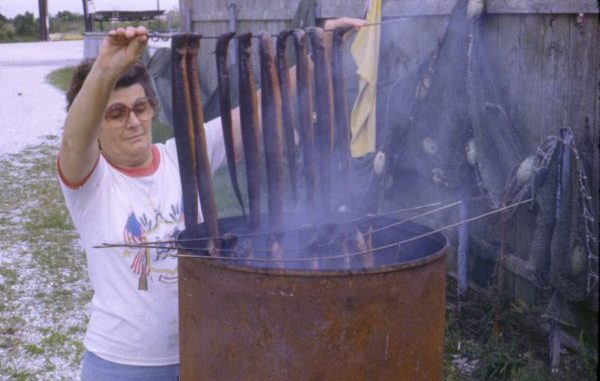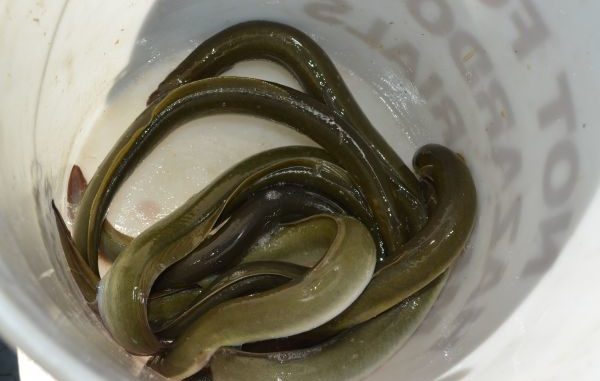
Loved everywhere but the United States
Nothing could be worse for a freshwater natural-bait fisherman. Something obviously huge had grabbed the worm or crawfish on his hook and was fighting furiously. He could almost imagine the broad head of a big catfish emerging from the water.
Instead, a writhing green ball of slime popped into sight. Too slippery to hold, the angler gave up in disgust and simply cut the line.
American eels are a great mystery fish. For centuries, no one had ever seen an eel with eggs or sperm, yet eels appeared everywhere in freshwater — even lakes that were previously dry and cut off from rivers and streams.
Speculation about the origins of freshwater eels began with the Greek philosopher Aristotle (384-322 B.C.), who claimed that eels were incapable of spawning and emerged by spontaneous generation from earthworms.
Our hero, the American eel, whose scientific name Anguilla rostra in Latin translates as “eel” and “beaked,” is one of 700 or so species of eels worldwide. Fourteen eel families are exclusively marine (morays, congers and the like), and a single family consisting of 16 species is freshwater — well, actually kind of freshwater.
American eels, and their close relatives Japanese eels and European eels, are catadromous, meaning that they live most of their life in freshwater but spawn in saltwater
Quite a few other fish species, such as striped bass, some herrings, sturgeon and salmon are anadromous, meaning they spend most of their life in saltwater but enter freshwater to spawn. American eels do it bass-ackwards.
It actually took centuries of sleuthing to work out the life cycle of freshwater eels. In 1923, a Danish researcher found very small eel larvae in the Sargasso Sea, a 2 million-square-mile zone in the middle of the North Atlantic Ocean. The Sargasso Sea is surrounded by clockwise-running currents and is named after the vast tracts of Sargassum seaweeds that accumulate there.
The presence of the larvae seemed proof that freshwater eels spawned there, but to this date no one has ever found a mature adult eel in the Atlantic. (In 2008 and 2009, biologists did find 10 sexually mature Japanese eels in the Pacific Ocean.)
In spite of some gaps in the research, the life cycle of the American eel has been pretty well worked out. After hatching, the larval eels are called “leptocephali,” which means “slim head” in Latin. Not only do they have small heads, their leaf-like flattened bodies are so crystal clear that one can read a newspaper through them.
These leptocephali (singular is leptocephalus) float in the circular currents of the Sargasso Sea for about a year before hopping off and heading for the American Gulf of Mexico and Atlantic coasts.

As they near land, the bodies of the 2 ½-inch larvae become rounder in cross section, and physical changes occur that will allow them to survive in freshwater. These are called “glass eels.”
Once they reach the coast, they begin to swim upstream, and changes continue in their bodies. At about 6 inches long, their color darkens to the normal muddy yellow-brown-green color and they are called “yellow eels,” a name that sticks with them for the five to 25 years they will spend feeding, growing and storing fat.
In general, males are smaller than females, and are more likely to stay near the coast. Females, which can grow to 5 feet long, will penetrate the interior of the continent as far up the Mississippi and Missouri rivers as South Dakota. They enter lakes and reservoirs by climbing the wet walls of dams or squirming overland through wet grass.
One theory about this is that an eel can become either a male or a female, depending on environmental conditions. In crowded conditions where competition for food is strong, they become males. In areas of low eel population and low competition for food, they become females.
At some point after five years, eels change again. Their digestive systems shrink to the point of disappearing and they no longer feed, living off their huge fat reserves. Color also changes during their migration downriver toward their spawning grounds in the sea; their backs darken, and their bellies whiten. These are called “silver eels.” At the silver eel stage, males are less than 16 inches long and females are over 16 inches.
American eels are highly adaptable, and can live in a variety of habitats — ranging from clear water, hard bottom streams to muddy bottom backwater sloughs and lakes — during their years in freshwater. Little research has been done on their food habits, but it is known that they eat virtually anything, including insects, crawfish and fish. They will feed round the clock, but most feeding activity takes place at night.
Because of the extremely high fat content of their flesh, freshwater eels have a culinary following all over the world, except in the United States. Japan consumes huge quantities of eels, most of it prepared as kabiyaki — slices of butterflied eels that are marinated in a soy-based sweet sauce and grilled.
Europeans have a love affair with eels, as well. In Britain, they eat them jellied or stewed. The French cook them in a red wine sauce. Italians grill them. In Scandinavia, Germany and the Netherlands, eels are loved smoked.
Smoked Dutch-style, their flesh resembled rich-tasting pork with seafood overtones.
In the mid- to late 1970s a Louisiana seafood buyer, May Usannaz, tried to establish a commercial eel fishery for export first to the Netherlands and then to Sweden. In spite of many tons being shipped, the fishery never became solidly established.
The biggest objections fishermen had were their resemblance to snakes and the need to hold them in live tanks onboard the fishing vessel until they were sold.
Unfortunately, most American fishermen who take a stab at experimenting with eels on the table fry them in typical American fish style. The extremely high fat content of eels makes them virtually inedible when so treated.


